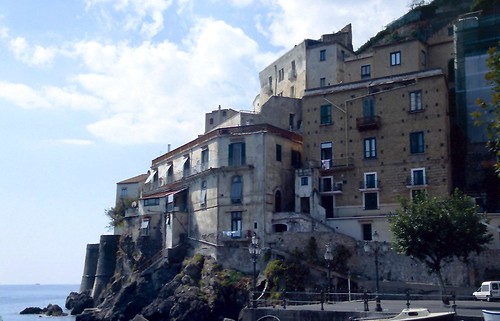 We left Naples, turned off the Autostrada, and headed off into the hills. We tuned off the main road, and the road soon became steep, with many sharp turns and hairpin bends. All along the increasingly high cliff, small villages clinged on to the earth. And over our shoulders, the bay of Naples, along with the volcano stretched out into the haze of the horizon. After about 45 minutes, we entered a short tunnel, as the road gave up trying to get over the summit of the hill. We came out in a typical Italian village, small houses, all with blinds firmly down, a few children on the way home from school, a white church. And then, the most amazing few came into sight. We were perched at the top of a cliff, some two thousand feet high, and it fell away very steeply to the Mediterranean below.
We left Naples, turned off the Autostrada, and headed off into the hills. We tuned off the main road, and the road soon became steep, with many sharp turns and hairpin bends. All along the increasingly high cliff, small villages clinged on to the earth. And over our shoulders, the bay of Naples, along with the volcano stretched out into the haze of the horizon. After about 45 minutes, we entered a short tunnel, as the road gave up trying to get over the summit of the hill. We came out in a typical Italian village, small houses, all with blinds firmly down, a few children on the way home from school, a white church. And then, the most amazing few came into sight. We were perched at the top of a cliff, some two thousand feet high, and it fell away very steeply to the Mediterranean below. 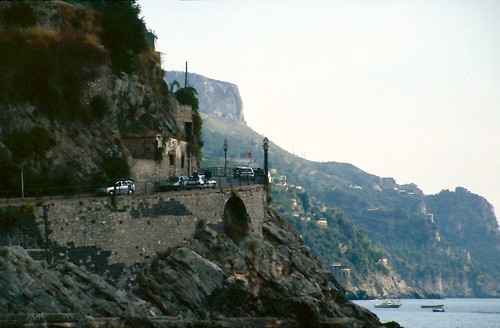 Scattered along the cliff, were small villages, along with the white churches. And the knowledge that we were going to have to get down the cliff on what constituted the road. At one point, we counted 12 levels of the road below us. Churches that were ten minutes ago, were hundreds of feet below us, appeared around the hairpin bends. Only to be towering above us a few minutes later. Sitting at the window seat, to see the sea below, and only a thin metal fence separating the bus from tumbling down the cliff was sobering. The driver was brilliant, and dealt with oncoming vehicles by stopping the bus right next to the railings. It took the best part of an hour to negotiate the road down to sea level.
Scattered along the cliff, were small villages, along with the white churches. And the knowledge that we were going to have to get down the cliff on what constituted the road. At one point, we counted 12 levels of the road below us. Churches that were ten minutes ago, were hundreds of feet below us, appeared around the hairpin bends. Only to be towering above us a few minutes later. Sitting at the window seat, to see the sea below, and only a thin metal fence separating the bus from tumbling down the cliff was sobering. The driver was brilliant, and dealt with oncoming vehicles by stopping the bus right next to the railings. It took the best part of an hour to negotiate the road down to sea level.  And unfortunately, there were no parking places big enough for a bus, so I have no pictures of that trip. But it will live in my memory for a long time. One woman was so scared; she did not leave the town with the hotel for the whole week. And tried very hard to find another way to get to the airport when we came to leave. As we drove along the main Amalfi coast road, we realised it was no wider than the one we came down on. So, progress was very slow at time. But, after passing through the main town of the coastline, Amalfi itself, we came to our base for the next week, Minori. Minori is a small fishing village, with a harbour, a few shops, mainly for locals, a large church, and a small square with a couple of bars. The town is built into a cleft in the cliff, with narrow streets. Too narrow for busses, so we stopped on the main road, and walked up to our hotel.
And unfortunately, there were no parking places big enough for a bus, so I have no pictures of that trip. But it will live in my memory for a long time. One woman was so scared; she did not leave the town with the hotel for the whole week. And tried very hard to find another way to get to the airport when we came to leave. As we drove along the main Amalfi coast road, we realised it was no wider than the one we came down on. So, progress was very slow at time. But, after passing through the main town of the coastline, Amalfi itself, we came to our base for the next week, Minori. Minori is a small fishing village, with a harbour, a few shops, mainly for locals, a large church, and a small square with a couple of bars. The town is built into a cleft in the cliff, with narrow streets. Too narrow for busses, so we stopped on the main road, and walked up to our hotel. 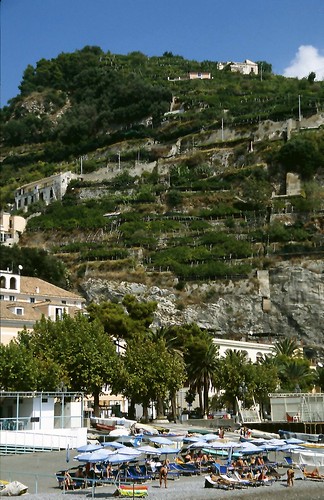 The hotel was very nice, all staff in white coast and ties, and nothing was too much trouble. They even brought our cases up from the harbour, and delivered them right up to our rooms, something I don’t think would have happened in England. My room was much bigger than the one in Tuscany. In that one I could have a shower, shave, clean my teeth, and use the bidet and toilet, without moving. My room here, we big, though strangely, the bathroom was bigger than the bedroom. But, it was good, and there was a mini bar, with the typical overpriced stuff.
The hotel was very nice, all staff in white coast and ties, and nothing was too much trouble. They even brought our cases up from the harbour, and delivered them right up to our rooms, something I don’t think would have happened in England. My room was much bigger than the one in Tuscany. In that one I could have a shower, shave, clean my teeth, and use the bidet and toilet, without moving. My room here, we big, though strangely, the bathroom was bigger than the bedroom. But, it was good, and there was a mini bar, with the typical overpriced stuff.  That night, we met in the bar, and had a welcome drink provided by the hotel, and once again divided into our little cliques to sit at our various tables. I sat with a couple from Swindon, John and his wife, the two sisters, and a lone lady called Vicky, who was 80, and on her own, having recovered from a minor stroke. John and I had very similar sense of humour, which spelt trouble for others, as we could be found doubled up in laughter at someone else’s slip of the tongue. There was a separate wine waiter, and John and I decided to take turns in buying a bottle of wine, one each day. Which worked out quite well.
That night, we met in the bar, and had a welcome drink provided by the hotel, and once again divided into our little cliques to sit at our various tables. I sat with a couple from Swindon, John and his wife, the two sisters, and a lone lady called Vicky, who was 80, and on her own, having recovered from a minor stroke. John and I had very similar sense of humour, which spelt trouble for others, as we could be found doubled up in laughter at someone else’s slip of the tongue. There was a separate wine waiter, and John and I decided to take turns in buying a bottle of wine, one each day. Which worked out quite well. The next day was a gentle one, beginning with a guided walking tour around the town. We went to a coffee shop, to try the locally made pastries, and sample the traditional expresso. From there we went to a ceramic workshop, majolica is made all along the coast, and is decorated with fruits. A popular figure was that of Bacchus, the Roman God of wine and feasting, we were to see his grinning face all along the coast. Finally, we went to a pasta shop, where pasta is made by hand. And there, as everywhere else, they had their own local shaped pasta, which was made by wrapping the pasta around a wire, and rolling the pasta along the work surface. It was very expensive, as each piece was hand made, and could not be machine made. The shops and workshops were found along narrow alleyways that criss-crossed the town. And at the end of the alleys, the sides of the cliffs could be seen reaching to the heavens.
The next day was a gentle one, beginning with a guided walking tour around the town. We went to a coffee shop, to try the locally made pastries, and sample the traditional expresso. From there we went to a ceramic workshop, majolica is made all along the coast, and is decorated with fruits. A popular figure was that of Bacchus, the Roman God of wine and feasting, we were to see his grinning face all along the coast. Finally, we went to a pasta shop, where pasta is made by hand. And there, as everywhere else, they had their own local shaped pasta, which was made by wrapping the pasta around a wire, and rolling the pasta along the work surface. It was very expensive, as each piece was hand made, and could not be machine made. The shops and workshops were found along narrow alleyways that criss-crossed the town. And at the end of the alleys, the sides of the cliffs could be seen reaching to the heavens.That afternoon, we met at the harbour for the afternoon’s excursion, a boat trip to Positano.
Positano is a town about 15 miles along the coast to Naples, and is built on a steep cliff. All the houses and shops are either pastel coloured of whitewashed, and linked by steep alleyways.
We agreed to split up for lunch, my group to the bar we had visited the night before for salad and iced tea, which had introduced the group to. Just before one, we met up on the quay for the arrival of our boat to take us to Positano. It was a converted fishing boat, with seating around the sides. And the guide gave us a commentary all along the coast as to what interesting places we could see. It turned out to be either 5 star hotels whose prices we could not dream of affording, or the summer homes of the rich and famous. At the midway point, we stopped off at the azure grotto. The grotto is a cave, with an underwater entrance, which when the sun shines has the most wonderful colour. It is reached from a small jetty, and along a narrow passageway, to a small quay, where small rowing boats were waiting to take us into the cave. It was wonderful, and even better, as we returned to the quay, the rower splashed with his oar, and the surface sparkled as if suddenly covered with jewels. All an optical effect, but wonderful none the less.
 Positano is he most famous place on the Amalfi coast, it was crowded, until we learned what crowds really were later in the week. Our group split up, with most going with the tour guide who promised them the best patisserie on the Naples Rivera. In the end, we all ended up there, sampling the homemade apricot tea and ice cram. There were narrow passageways, all with shops built into the walls. And the clothes shop had their wares hanging on the side of the walls outside, forcing passing people to force their way through the dresses and t-shirts. It reminded me of The Lion, The Witch and the Wardrobe, expecting to come out in an arctic wood at some point.
Positano is he most famous place on the Amalfi coast, it was crowded, until we learned what crowds really were later in the week. Our group split up, with most going with the tour guide who promised them the best patisserie on the Naples Rivera. In the end, we all ended up there, sampling the homemade apricot tea and ice cram. There were narrow passageways, all with shops built into the walls. And the clothes shop had their wares hanging on the side of the walls outside, forcing passing people to force their way through the dresses and t-shirts. It reminded me of The Lion, The Witch and the Wardrobe, expecting to come out in an arctic wood at some point.
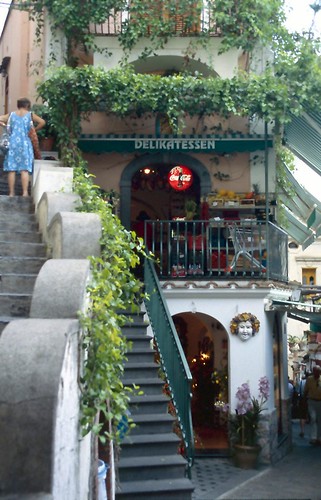 There is noting quite like sitting in the shade of an Italian coffee shop, eating Pistachio Ice Cream, and watching the world go by. So good in fact, we soon had coffee to go with the ice cream too. The journey back was wonderful, as the cliffs caught the setting sun, and the air was full of the smell of burning leaves as the farmers burnt that days rubbish from the groves and vineyards. As we headed away from Positano, Capri was just viable as we looked into the setting sun, silhouetted against the bright sky. It looked wonderful, and we would be going there at the weekend.
There is noting quite like sitting in the shade of an Italian coffee shop, eating Pistachio Ice Cream, and watching the world go by. So good in fact, we soon had coffee to go with the ice cream too. The journey back was wonderful, as the cliffs caught the setting sun, and the air was full of the smell of burning leaves as the farmers burnt that days rubbish from the groves and vineyards. As we headed away from Positano, Capri was just viable as we looked into the setting sun, silhouetted against the bright sky. It looked wonderful, and we would be going there at the weekend. Next day was an extended half-day trip to Paestum. We were wondering what the difference between a half-day, extended half day and a full day trip. In the end it seemed to be about half an hour each. Paestum is away from the Amalfi coast, beyond Solerno. The drive along the coast was spectacular to say the least. The road was never more than two cars width, and we were in a big bus. So, other traffic had to get out the way, unless two busses met, in which case it was interesting. At times the road was level with the sea, and others it climbed hundreds of feet above the ocean. We passed through small fishing villages, around gorges cut into the face of the cliffs. The last town before Solerno made ceramics as its speciality. And all the churches along the coast had tiled domes that caught the sun. All the shops on the main street had tiled fronts, depicting what could be bought inside.
Next day was an extended half-day trip to Paestum. We were wondering what the difference between a half-day, extended half day and a full day trip. In the end it seemed to be about half an hour each. Paestum is away from the Amalfi coast, beyond Solerno. The drive along the coast was spectacular to say the least. The road was never more than two cars width, and we were in a big bus. So, other traffic had to get out the way, unless two busses met, in which case it was interesting. At times the road was level with the sea, and others it climbed hundreds of feet above the ocean. We passed through small fishing villages, around gorges cut into the face of the cliffs. The last town before Solerno made ceramics as its speciality. And all the churches along the coast had tiled domes that caught the sun. All the shops on the main street had tiled fronts, depicting what could be bought inside. 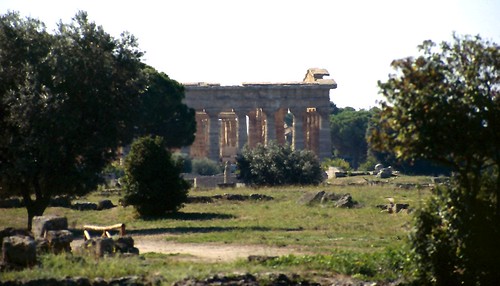 Paestum was built on the plains south of Solerno, between what were swamps in antiquity. As the towns got poorer as went slowly south, the beachside shops slowly falling into decay. We turned inland, over lazy rivers meandering through reed banks. We came upon massive walls. This was Paestum. Inside was a Roman town, but even better, three classic Greek temples from half a millennia before Christ. The temples towered over what was left of the town, and wonderfully, they we in remarkable condition. Two of the temples were next to each other, and even the inner sanctum of one was still there. All that were missing were the roofs.
Paestum was built on the plains south of Solerno, between what were swamps in antiquity. As the towns got poorer as went slowly south, the beachside shops slowly falling into decay. We turned inland, over lazy rivers meandering through reed banks. We came upon massive walls. This was Paestum. Inside was a Roman town, but even better, three classic Greek temples from half a millennia before Christ. The temples towered over what was left of the town, and wonderfully, they we in remarkable condition. Two of the temples were next to each other, and even the inner sanctum of one was still there. All that were missing were the roofs.
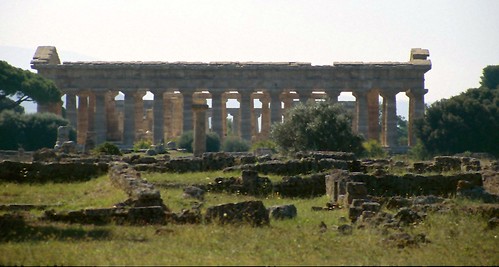 Nearby, was a museum, were the marble facing was still preserved. It seemed that the Romans left previous civilisation’s religious buildings along, even incorporating them into their own beliefs. Christian church builders however, cannibalised anything they could get their hands on to build the early churches. Paestum survived because it was in the middle of a swap, and remained undiscovered for over 1500 years. What was even more wonderful about it, was that it is relatively unknown, and we had the site almost to ourselves. Once we had toured the site and museum, we had lunch in a nearby taverna, more local soft cheese and tomato salad.
Nearby, was a museum, were the marble facing was still preserved. It seemed that the Romans left previous civilisation’s religious buildings along, even incorporating them into their own beliefs. Christian church builders however, cannibalised anything they could get their hands on to build the early churches. Paestum survived because it was in the middle of a swap, and remained undiscovered for over 1500 years. What was even more wonderful about it, was that it is relatively unknown, and we had the site almost to ourselves. Once we had toured the site and museum, we had lunch in a nearby taverna, more local soft cheese and tomato salad.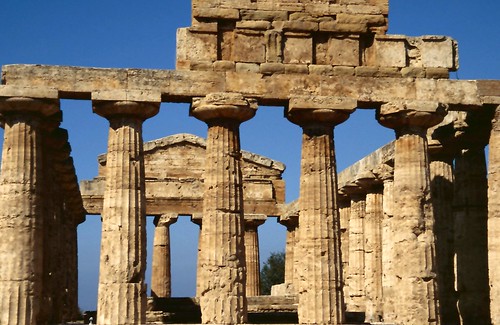 It had been a hot day, so I thought I would treat myself to a proper Italian haircut. There was a barber on the walk up to the hotel from the harbour, so I thought I would give it a try.
It had been a hot day, so I thought I would treat myself to a proper Italian haircut. There was a barber on the walk up to the hotel from the harbour, so I thought I would give it a try.
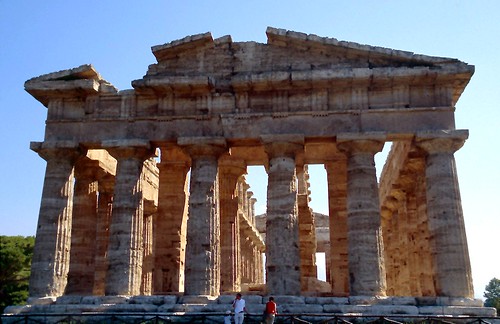 Good luck was that he was open, and no one was waiting. We got on really well, I spoke no Italian, and unlike everyone else in Italy, he spoke no English. He guessed I wanted a haircut, and soon he was cutting away, and hair was flying off in all directions. He finished, and I motioned to get up, he said to wait. And snipped away at my eyebrows. Once again I went to get up, and he motioned to stay sitting. What happened next was not what I expected, he changed the grip on the scissors, and put them up my nose, a quick snip to get rid of any hairs, up the other nostril, and snip. And, it was all over. Oh how I laughed, and so did my friends in the bar when I told them.
Good luck was that he was open, and no one was waiting. We got on really well, I spoke no Italian, and unlike everyone else in Italy, he spoke no English. He guessed I wanted a haircut, and soon he was cutting away, and hair was flying off in all directions. He finished, and I motioned to get up, he said to wait. And snipped away at my eyebrows. Once again I went to get up, and he motioned to stay sitting. What happened next was not what I expected, he changed the grip on the scissors, and put them up my nose, a quick snip to get rid of any hairs, up the other nostril, and snip. And, it was all over. Oh how I laughed, and so did my friends in the bar when I told them.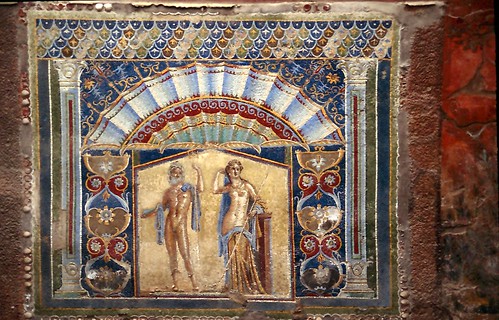 Friday was a trip to Herculaneum, famous of course, for being one of the other towns to be destroyed by the ad 79 eruption of Vesuvius. The entrance to the site is among the busiest part of Naples, with the clouded shadow of the volcano towering above us. The locals dislike the visiting tourists, as the tour busses whisk to visitors to the site, and away again after the visit. So, almost no tourist money is spent in the area. We were warned of pickpockets, and worse, so to keep together on the walk to the pick up place for the bus. In reality, we saw a slice of normal Italian life, shops, garages, workshops that would have been great to look around, and maybe snap pictures of. But, it was not to be. Traffic was doubly bad, as the local government had organised a protest march of tow aid workers captured in Iraq, so thousands of schoolchildren with banners brought the city to a standstill. By the end of the week, the workers would be freed, at least some good news for the city.
Friday was a trip to Herculaneum, famous of course, for being one of the other towns to be destroyed by the ad 79 eruption of Vesuvius. The entrance to the site is among the busiest part of Naples, with the clouded shadow of the volcano towering above us. The locals dislike the visiting tourists, as the tour busses whisk to visitors to the site, and away again after the visit. So, almost no tourist money is spent in the area. We were warned of pickpockets, and worse, so to keep together on the walk to the pick up place for the bus. In reality, we saw a slice of normal Italian life, shops, garages, workshops that would have been great to look around, and maybe snap pictures of. But, it was not to be. Traffic was doubly bad, as the local government had organised a protest march of tow aid workers captured in Iraq, so thousands of schoolchildren with banners brought the city to a standstill. By the end of the week, the workers would be freed, at least some good news for the city.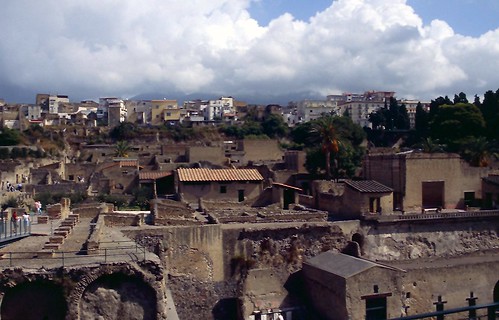 We approach the site along a shallow sloping ramp; with views overlooking what has been explored so far. So we had views over the whole site, which is not very big, about the same size a 8 city blocks, as the rest is under the city of Naples. Straight narrow streets led to what was once the waterfront, but is now 200 feet above sea level, and over a mile from the current shoreline. Once again, a guide was waiting for us, and he told us a little about what is know of the town. It was a much smaller place than Pompeii, but still much has been learned from the finds there.
We approach the site along a shallow sloping ramp; with views overlooking what has been explored so far. So we had views over the whole site, which is not very big, about the same size a 8 city blocks, as the rest is under the city of Naples. Straight narrow streets led to what was once the waterfront, but is now 200 feet above sea level, and over a mile from the current shoreline. Once again, a guide was waiting for us, and he told us a little about what is know of the town. It was a much smaller place than Pompeii, but still much has been learned from the finds there. 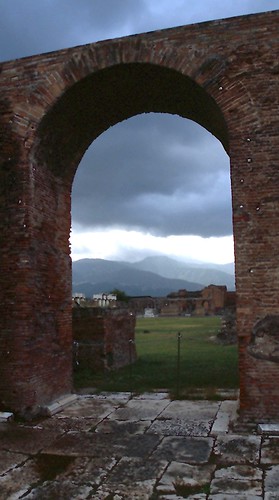 Most wonderful, was that due to the way the town was covered, a lot of organic material survived, as well as hundreds of mosaics. The mosaics looked as if they were laid yesterday, and it was odd to be able to walk over them. One villa had wonderful mosaics on the wall, with full perspective views of building. Such art would not be done again in mainland Europe until the Renaissance. Due to the fact, so much ash over 30 metres high. And above that, sides of blocks of flats towered even higher. Organic material had survived, it was possible to tell what plants had grown in the gardens of the villas, and new plants had been planted, making the impression that the owners of the villas had just left. A very odd feeling indeed. At the side of the site, walls of and above it all, Vesuvius, green and serene. The highlight of the tour, was a villa of a rich merchant, and hidden away at the back, was the most wonderful mosaic on the wall, and a tiled alter to the local Gods. All looking like they were brand new.
Most wonderful, was that due to the way the town was covered, a lot of organic material survived, as well as hundreds of mosaics. The mosaics looked as if they were laid yesterday, and it was odd to be able to walk over them. One villa had wonderful mosaics on the wall, with full perspective views of building. Such art would not be done again in mainland Europe until the Renaissance. Due to the fact, so much ash over 30 metres high. And above that, sides of blocks of flats towered even higher. Organic material had survived, it was possible to tell what plants had grown in the gardens of the villas, and new plants had been planted, making the impression that the owners of the villas had just left. A very odd feeling indeed. At the side of the site, walls of and above it all, Vesuvius, green and serene. The highlight of the tour, was a villa of a rich merchant, and hidden away at the back, was the most wonderful mosaic on the wall, and a tiled alter to the local Gods. All looking like they were brand new. Saturday should have been a trip to the Island of Capri, but bad weather with strong winds had kept all boats in harbour Friday and Saturday, so the final trip to Pompeii was brought forward a day, and Capri would be on Sunday. So, once more we set out on the bus along the twisty coast road to Solerno. By now we were so used to passing other coaches and lorries, that we hardly paid any attention. It turns out that for most Italian bus drivers, a trip along this road is the last part of their driving test, as the logic goes, if you can drive along there, you can drive on any road. Stories, whether true or not, abound of inexperienced drivers abandoning their vehicles along with passengers, as their nerves are frayed. Our guide told us of a driver having a mental breakdown whilst driving along it a couple of years ago. He was only able to continue after some wine, and taking most of his clothes off. Well, nothing like that happened to us, though some of the German coach drivers were looking none to happy, and had to be told how two busses could really pass each other on a hairpin bend, and yes, that does mean the end of your bus will be hanging over a 500 foot cliff, but yes, it is safe.
Saturday should have been a trip to the Island of Capri, but bad weather with strong winds had kept all boats in harbour Friday and Saturday, so the final trip to Pompeii was brought forward a day, and Capri would be on Sunday. So, once more we set out on the bus along the twisty coast road to Solerno. By now we were so used to passing other coaches and lorries, that we hardly paid any attention. It turns out that for most Italian bus drivers, a trip along this road is the last part of their driving test, as the logic goes, if you can drive along there, you can drive on any road. Stories, whether true or not, abound of inexperienced drivers abandoning their vehicles along with passengers, as their nerves are frayed. Our guide told us of a driver having a mental breakdown whilst driving along it a couple of years ago. He was only able to continue after some wine, and taking most of his clothes off. Well, nothing like that happened to us, though some of the German coach drivers were looking none to happy, and had to be told how two busses could really pass each other on a hairpin bend, and yes, that does mean the end of your bus will be hanging over a 500 foot cliff, but yes, it is safe.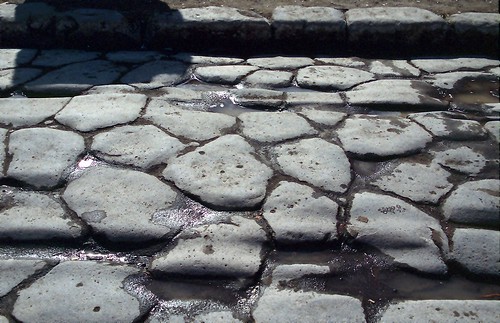 Pompeii is quite near to Herculaneum, and it was pointed out by some of the more tired members of our party that maybe we could have done both trips in the same day. Although Vicky was so tired after the climb back up from the site yesterday, she barely made it back to the bus. We were assured that Pompeii is much flatter than Herculaneum, so that should not be a problem. Although there was a quite steep walk to the entrance, we did not have to exit the site that way. By the time we reached the site, it was raining, and the climb that was mentioned was indeed steep.
Pompeii is quite near to Herculaneum, and it was pointed out by some of the more tired members of our party that maybe we could have done both trips in the same day. Although Vicky was so tired after the climb back up from the site yesterday, she barely made it back to the bus. We were assured that Pompeii is much flatter than Herculaneum, so that should not be a problem. Although there was a quite steep walk to the entrance, we did not have to exit the site that way. By the time we reached the site, it was raining, and the climb that was mentioned was indeed steep. 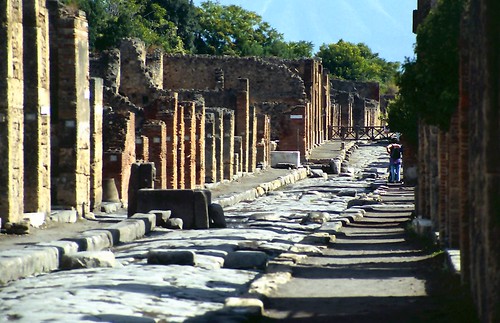 And worse than that, up stone steps without non-slip mats, or handrails to grip onto. So, we made our way slowly up the slope, through the town gates, and into the city itself. Pompeii has been excavated completely, and stretches for miles in all directions. It is also the most popular tourist site in Southern Italy, and most people go there at some point of their stay. We were told that it was the quietest our guides had ever seen it. But still, there were times when there were people jams, and it was impossible to gain entry to buildings. Most people travel around as a group with a guides, and there are places that just HAVE to be visited. I eventually left our group after waiting outside what used to be a brothel, as there were tow groups waiting to get in at the same time. Sorry, is it just me, but queuing up to see 2000 year old dirty pictures did not seem worth it.
And worse than that, up stone steps without non-slip mats, or handrails to grip onto. So, we made our way slowly up the slope, through the town gates, and into the city itself. Pompeii has been excavated completely, and stretches for miles in all directions. It is also the most popular tourist site in Southern Italy, and most people go there at some point of their stay. We were told that it was the quietest our guides had ever seen it. But still, there were times when there were people jams, and it was impossible to gain entry to buildings. Most people travel around as a group with a guides, and there are places that just HAVE to be visited. I eventually left our group after waiting outside what used to be a brothel, as there were tow groups waiting to get in at the same time. Sorry, is it just me, but queuing up to see 2000 year old dirty pictures did not seem worth it.  So, I headed off to quieter places in the site. And I found myself at a pair of theatres, and I had them just about to myself. As I sat in the upper row of seats, behind me, still shrouded in clouds was the ever-present shape of Vesuvius. I wish I could sound more enthusiastic about Pompeii, but the crowds meant that my memories are a little soured. The city fathers had a clever idea. All Roman carts had standard axle widths. But the streets in Pompeii had stepping stones to allow people to cross the streets. But they were positioned in such a way so that standard carts could not get passed.
So all visiting merchants had to hire a local cart to deliver their goods. The stepping-stones were necessary as the street were used as sewers and full of animal dung. It was interesting to note, that although Romans were famous for their straight road, the road to the brothel was in fact curved, so that the great and the good would not be seen entering from the main street. When I met up with the others from the party, I found out that they had been to the Amphitheatre, and impressive it was to, by all accounts.
After we left Pompeii, we took a short bus ride to a local restaurant that our guide knew, and for a reasonable price, etc. So, we sat down to a pleasant light meal of, my first Italian pizza. Was it better than Domino’s or Pizza Hut? Well, it was made fresh, and the cheese was better, I guess.
So, I headed off to quieter places in the site. And I found myself at a pair of theatres, and I had them just about to myself. As I sat in the upper row of seats, behind me, still shrouded in clouds was the ever-present shape of Vesuvius. I wish I could sound more enthusiastic about Pompeii, but the crowds meant that my memories are a little soured. The city fathers had a clever idea. All Roman carts had standard axle widths. But the streets in Pompeii had stepping stones to allow people to cross the streets. But they were positioned in such a way so that standard carts could not get passed.
So all visiting merchants had to hire a local cart to deliver their goods. The stepping-stones were necessary as the street were used as sewers and full of animal dung. It was interesting to note, that although Romans were famous for their straight road, the road to the brothel was in fact curved, so that the great and the good would not be seen entering from the main street. When I met up with the others from the party, I found out that they had been to the Amphitheatre, and impressive it was to, by all accounts.
After we left Pompeii, we took a short bus ride to a local restaurant that our guide knew, and for a reasonable price, etc. So, we sat down to a pleasant light meal of, my first Italian pizza. Was it better than Domino’s or Pizza Hut? Well, it was made fresh, and the cheese was better, I guess.
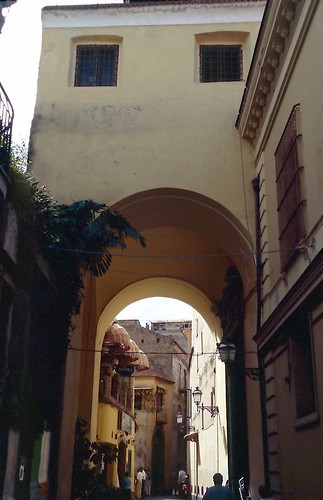 In the afternoon, we were to travel the other part of the Amalfi Coast Road, from Sorrento all the way to Amalfi and ten to where our hotel was in Minori. We were to have a stop in Sorrento as well, with chance to have a wander about, and do some shopping. Sorrento is situated on a peninsular at the southern end of the Bay of Naples, with stunning views across it. And as luck would have it, the sun came out, and it was pleasantly warm too.
In the afternoon, we were to travel the other part of the Amalfi Coast Road, from Sorrento all the way to Amalfi and ten to where our hotel was in Minori. We were to have a stop in Sorrento as well, with chance to have a wander about, and do some shopping. Sorrento is situated on a peninsular at the southern end of the Bay of Naples, with stunning views across it. And as luck would have it, the sun came out, and it was pleasantly warm too.
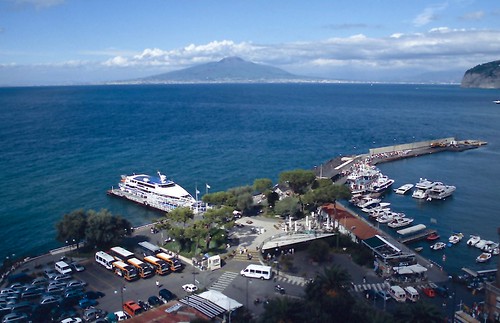 Sorrento is a fairly large town, and is a popular destination for English tourists. So, there was the usual scattering of English Pubs, and bars that did English Food, with brown sauce! After visiting so many out of the way places, and out of the package tour world, it was a shock. People were wandering around in vests, and had kin the colour of boiled lobster. However, the streets were narrow, but the shops were the usual tourist traps, selling the usual tat. So, I struck out to find a good view to photograph. I walked passed the Foreigners’ Club, where you could get a ‘proper’ cup of tea, and the usual English food. Quite why people go to a culinary rich country and want to eat fish fingers and baked beans is any ones guess.
Sorrento is a fairly large town, and is a popular destination for English tourists. So, there was the usual scattering of English Pubs, and bars that did English Food, with brown sauce! After visiting so many out of the way places, and out of the package tour world, it was a shock. People were wandering around in vests, and had kin the colour of boiled lobster. However, the streets were narrow, but the shops were the usual tourist traps, selling the usual tat. So, I struck out to find a good view to photograph. I walked passed the Foreigners’ Club, where you could get a ‘proper’ cup of tea, and the usual English food. Quite why people go to a culinary rich country and want to eat fish fingers and baked beans is any ones guess.
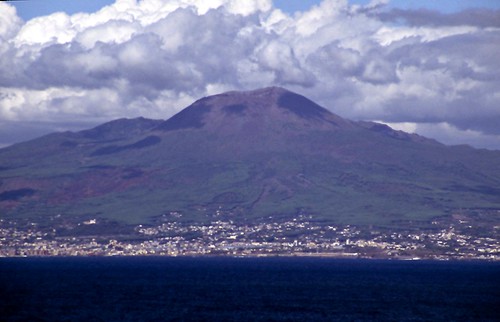 So, after passing the Foreigners Club, I continued down a curved road, until I saw what I had come looking for, a view to die for. Below me, was the harbour, with ferries either docking or just leaving, and a stream of busses carrying the tourists up the steep hill to the town. And beyond the harbour, the Bay of Naples, with Naples itself some 10 miles distant. And above Naples, Vesuvius, at last, out from it’s shroud of clouds, looking for all the world as though it was turfed all the way to the crater. It was not the middle of the afternoon, and it was quite warm. So, it was good to have the breeze coming in from the bay. Away to the left, was and the island of Capri, looking small and very hilly.
So, after passing the Foreigners Club, I continued down a curved road, until I saw what I had come looking for, a view to die for. Below me, was the harbour, with ferries either docking or just leaving, and a stream of busses carrying the tourists up the steep hill to the town. And beyond the harbour, the Bay of Naples, with Naples itself some 10 miles distant. And above Naples, Vesuvius, at last, out from it’s shroud of clouds, looking for all the world as though it was turfed all the way to the crater. It was not the middle of the afternoon, and it was quite warm. So, it was good to have the breeze coming in from the bay. Away to the left, was and the island of Capri, looking small and very hilly.
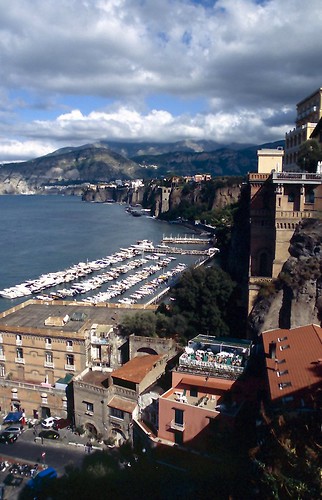 There was just enough time to find a nice café for an expresso and a glass of Sambuca, an aniseed flavoured liqueur that is very popular. And when if in Rome? I met up with Sue and Denise, who were now firm fans of iced tea. The drive back to the hotel was spectacular. Once again the road dipped and dived around the headlands of the Amalfi coast, twisted and turned along narrow gullies. We were able to stop at a parking area overlooking Positano. The views were breathtaking. There are times when words are not enough, and this was one of those times. We all leaned on the railings and just looked. There was a vegetable stall there as well, and we all stocked up on herbs and spices again, I was beginning to get very concerned that there was no way that all the wonderful things I bought was ever going to fit in my suitcase. We arrived back in Minori just as the sun was setting; the fairy lights had come on along the promenade. So, a couple of us stopped off at our favourite bar for a fortifying coffee and more Sambuca. That night, the menu in the hotel was not very inviting, so most of us decided to try a taverna a short way from the hotel. We had a wonderful meal, and the owners made us very welcome, giving us a bottle of the two liqueurs made in the town to finish the meal with. Much better than the fish they had at the hotel, apparently.
There was just enough time to find a nice café for an expresso and a glass of Sambuca, an aniseed flavoured liqueur that is very popular. And when if in Rome? I met up with Sue and Denise, who were now firm fans of iced tea. The drive back to the hotel was spectacular. Once again the road dipped and dived around the headlands of the Amalfi coast, twisted and turned along narrow gullies. We were able to stop at a parking area overlooking Positano. The views were breathtaking. There are times when words are not enough, and this was one of those times. We all leaned on the railings and just looked. There was a vegetable stall there as well, and we all stocked up on herbs and spices again, I was beginning to get very concerned that there was no way that all the wonderful things I bought was ever going to fit in my suitcase. We arrived back in Minori just as the sun was setting; the fairy lights had come on along the promenade. So, a couple of us stopped off at our favourite bar for a fortifying coffee and more Sambuca. That night, the menu in the hotel was not very inviting, so most of us decided to try a taverna a short way from the hotel. We had a wonderful meal, and the owners made us very welcome, giving us a bottle of the two liqueurs made in the town to finish the meal with. Much better than the fish they had at the hotel, apparently.
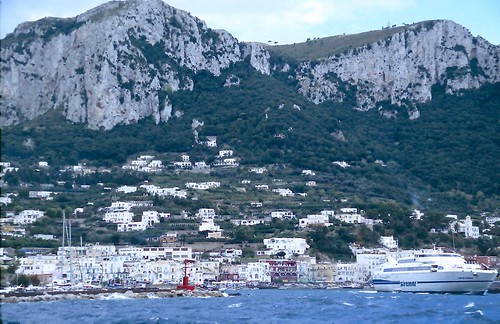 We had to be up early to get the boat to Capri. So, we met up, bleary eyed at breakfast. And then made our way to the quay. I was excited to be going to Capri, even it’s name sounded so glamorous. And, one of my favourite people, Spike Milligan had visited it during the war, finding it a delightful rural island, with quaint towns and chic cafes where it was possible to watch the world pass by. The world dressed up in their very best clothes of course. So, I was looking forward to the trip, a lot. As we once again made our way along the coast, the island came into view, and soon it was towering over us.
We had to be up early to get the boat to Capri. So, we met up, bleary eyed at breakfast. And then made our way to the quay. I was excited to be going to Capri, even it’s name sounded so glamorous. And, one of my favourite people, Spike Milligan had visited it during the war, finding it a delightful rural island, with quaint towns and chic cafes where it was possible to watch the world pass by. The world dressed up in their very best clothes of course. So, I was looking forward to the trip, a lot. As we once again made our way along the coast, the island came into view, and soon it was towering over us.
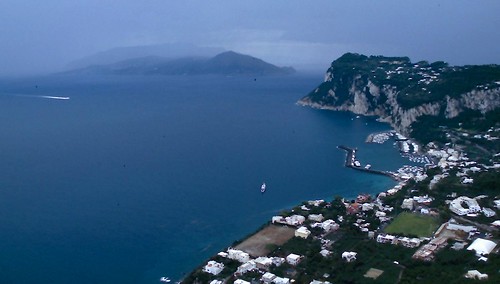 Sheer cliffs surround the island, apart from two places where it was possible to build a harbour. As I said before, visiting Capri had been impossible the past two days, and being a Sunday, it seemed that all of Naples, and all tourists had the same idea of going to Capri. To call the scenes on the harbour side chaos would be a gross understatement. Every five minutes another ferry would deposit hundreds of visitors, and the supply of mini busses were over-stretched. Mini busses have to be used, as the roads on the island are even narrower than those on the coast road.
Sheer cliffs surround the island, apart from two places where it was possible to build a harbour. As I said before, visiting Capri had been impossible the past two days, and being a Sunday, it seemed that all of Naples, and all tourists had the same idea of going to Capri. To call the scenes on the harbour side chaos would be a gross understatement. Every five minutes another ferry would deposit hundreds of visitors, and the supply of mini busses were over-stretched. Mini busses have to be used, as the roads on the island are even narrower than those on the coast road.
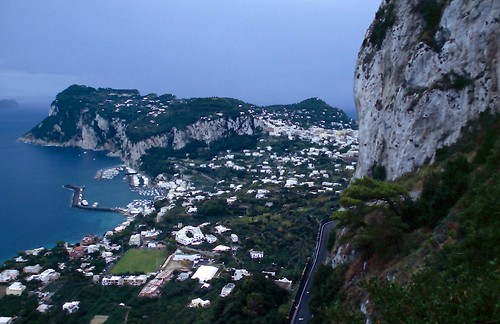 There seems to be no limits on how many people can visit the island on any day, so more and more people poured onto the island. Capri itself is small. About 10 square miles, and rises to over 2300 feet tall. There are three towns on the island, all of them geared to tourists and their apparent desire to buy even more tat. But being Capri, it was very over priced tat. The first town we visited was Ana Capri, built on a hill, narrow streets, full of touristy shops, and FULL of people. We were taken to a place the guide recommended, as always. And we had a lovely stone cold meal of what they decided to give us. And then charged us double what it would have cost on the mainland. The one saving grace that the town had is stunning views. Along from the main square, along the narrow street with its tourist shops, you come to a lookout. A sheer drop of over 1500 feet, overlooking the main harbour, across to the Sorrento peninsular, and across the bay to Naples and the volcano. But as the weather was so bad, a steady rain was falling, the volcano was almost obscured, and we could see the sheets of rain from the next rain cloud coming towards us. It made for a dramatic picture, though.
There seems to be no limits on how many people can visit the island on any day, so more and more people poured onto the island. Capri itself is small. About 10 square miles, and rises to over 2300 feet tall. There are three towns on the island, all of them geared to tourists and their apparent desire to buy even more tat. But being Capri, it was very over priced tat. The first town we visited was Ana Capri, built on a hill, narrow streets, full of touristy shops, and FULL of people. We were taken to a place the guide recommended, as always. And we had a lovely stone cold meal of what they decided to give us. And then charged us double what it would have cost on the mainland. The one saving grace that the town had is stunning views. Along from the main square, along the narrow street with its tourist shops, you come to a lookout. A sheer drop of over 1500 feet, overlooking the main harbour, across to the Sorrento peninsular, and across the bay to Naples and the volcano. But as the weather was so bad, a steady rain was falling, the volcano was almost obscured, and we could see the sheets of rain from the next rain cloud coming towards us. It made for a dramatic picture, though.

2 comments:
Hi Ian, just caught up with this blog - good stuff!
Good to see that you got to Paestum (per my blog of yonks ago) and the report of your trip around this part of Italy brings back memories.
All the best,
Steve
PS I assume you know that the landlord of The Berry in Walmer is also a Norwich fan?
Hi Steve,
Many thanks.
I have been posting some old writings mixed with stuff about my life, so this was from 2004 I think.
I know Chris very well, and the Berry.
Post a Comment